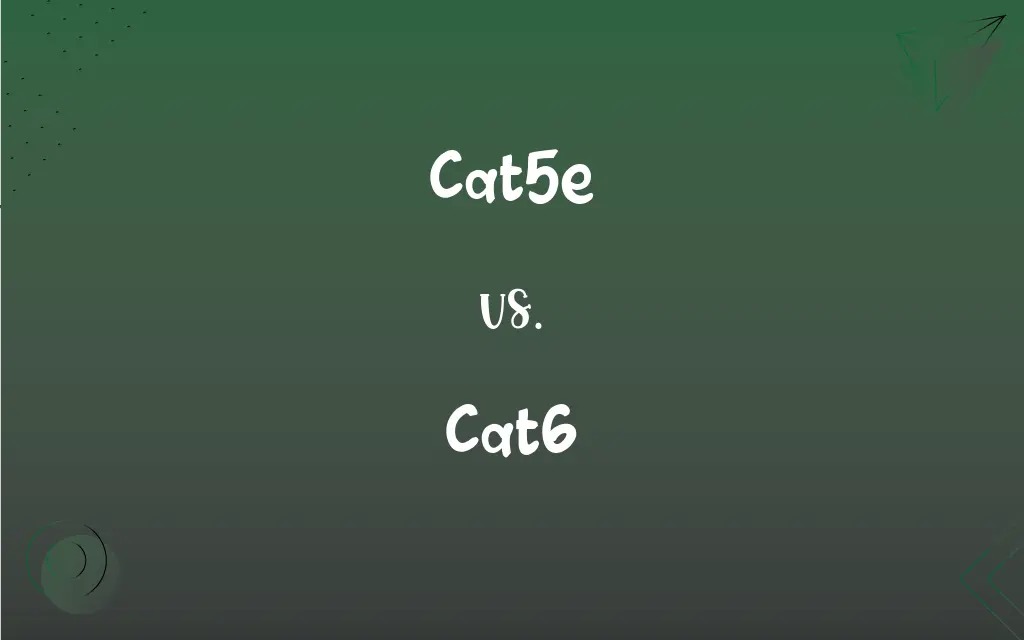Cat5e vs. Cat6: What's the Difference?
Edited by Aimie Carlson || By Janet White || Published on January 7, 2024
Cat5e (Category 5 enhanced) is a standard of network cable supporting up to 1 Gbps speeds, while Cat6 (Category 6) supports up to 10 Gbps with less crosstalk.

Key Differences
Cat5e cables are designed to support Ethernet networks at speeds up to 1 Gbps and are widely used for home and office networks. Cat6 cables are an advancement, supporting speeds up to 10 Gbps, making them suitable for more data-intensive applications.
In terms of frequency, Cat5e operates at up to 100 MHz, which is sufficient for most general uses. Cat6, on the other hand, operates at up to 250 MHz, providing higher performance for applications like video streaming and gaming.
Cat5e cables are known for their affordability and reliability in connecting various network devices. Cat6 cables, while slightly more expensive, offer improved network performance and are better suited for environments with higher data transfer demands.
When it comes to crosstalk, or signal interference, Cat5e offers enhancements over older Cat5 cables. However, Cat6 goes a step further by including tighter twists and a separator to reduce crosstalk even more efficiently.
Cat5e is often chosen for current network needs with an eye on cost-effectiveness. Cat6, being more future-proof, is selected by those looking to ensure their network can handle increasing data speeds and bandwidth demands.
ADVERTISEMENT
Comparison Chart
Speed Capacity
Up to 1 Gbps
Up to 10 Gbps
Frequency
Up to 100 MHz
Up to 250 MHz
Crosstalk Protection
Enhanced from Cat5
Superior to Cat5e
Cost
Generally less expensive
Slightly more expensive
Suitability
Home and small office networks
Data-intensive environments
ADVERTISEMENT
Cat5e and Cat6 Definitions
Cat5e
Cat5e is known for balancing performance and cost in network setups.
They opted for Cat5e in their small business to maintain a budget-friendly yet efficient network.
Cat6
Cat6 is a category of Ethernet cable that offers higher performance with speeds up to 10 Gbps.
For their high-speed gaming setup, they installed Cat6 cabling.
Cat5e
Cat5e operates at a frequency up to 100 MHz, suitable for general applications.
For their standard office network, Cat5e's 100 MHz frequency was adequate.
Cat6
Cat6 is often chosen for its future-proof capabilities in networking.
Anticipating future network upgrades, they installed Cat6 cables throughout the building.
Cat5e
Cat5e is an enhanced version of Cat5 cable supporting Ethernet networks up to 1 Gbps.
The office network was wired with Cat5e to support their daily data needs.
Cat6
Cat6, while more expensive than Cat5e, offers a significant boost in network capacity.
Despite the higher cost, they opted for Cat6 for its long-term network efficiency.
Cat5e
Cat5e cables are used for structured cabling for computer networks such as Ethernet.
He used Cat5e for connecting his home devices to the internet.
Cat6
Cat6 includes additional crosstalk protection, making it suitable for environments with heavy data traffic.
To minimize interference in their dense network, the company upgraded to Cat6.
Cat5e
Cat5e offers improved crosstalk reduction compared to its predecessor.
Cat5e was chosen for its ability to reduce network interference in the crowded office setup.
Cat6
Cat6 cables operate at frequencies up to 250 MHz, providing enhanced network performance.
The new data center was equipped with Cat6 to handle the high-frequency requirements.
FAQs
Do Cat5e and Cat6 use the same connectors?
Yes, both typically use standard RJ45 connectors.
Is Cat6 better for future-proofing a network?
Yes, Cat6's higher speed and frequency support make it more future-proof.
What are Cat5e cables primarily used for?
Cat5e is used for Ethernet networks in homes and offices, supporting speeds up to 1 Gbps.
Can Cat5e handle Gigabit Ethernet?
Yes, Cat5e can support Gigabit Ethernet, although it's at the upper limit of its capacity.
Can I mix Cat5e and Cat6 in a network?
Yes, but the network speed will be limited to the lowest category cable used.
Are Cat6 cables thicker than Cat5e?
Often, yes, due to more stringent shielding requirements.
Is Cat5e suitable for VoIP applications?
Yes, Cat5e is typically sufficient for VoIP.
How long can Cat5e and Cat6 cables run?
Both can effectively run up to 100 meters without signal degradation.
Is Cat6 necessary for a home network?
It depends on the network needs; Cat6 is beneficial for high-bandwidth applications.
Are Cat6 cables more expensive than Cat5e?
Generally, Cat6 cables are slightly more expensive due to their enhanced performance features.
Is Cat5e still relevant for new installations?
Yes, for many applications, especially where high bandwidth is not required.
Can environmental factors affect Cat5e and Cat6 performance?
Yes, factors like temperature and electromagnetic interference can impact performance.
Are there different types of Cat5e and Cat6 cables?
Yes, they come in different types, like shielded (STP) or unshielded (UTP).
Is it easy to install Cat6 over Cat5e?
The process is similar, but Cat6 may require more careful handling due to thicker cables.
Should I use Cat6 for video streaming?
Cat6 is a good choice for high-quality, uninterrupted video streaming.
How do I know if I need Cat5e or Cat6?
It depends on your network speed requirements, budget, and future-proofing considerations.
Can Cat6 support 10 Gigabit Ethernet?
Yes, but over shorter distances compared to specialized cables like Cat6a.
Does Cat6 offer better internet speed?
It offers better potential speeds but is limited by the speed provided by the ISP.
Are Cat5e and Cat6 backward compatible?
Yes, they are backward compatible with older Ethernet technologies.
Does Cat6 reduce crosstalk more effectively than Cat5e?
Yes, Cat6 has better crosstalk reduction capabilities.
About Author
Written by
Janet WhiteJanet White has been an esteemed writer and blogger for Difference Wiki. Holding a Master's degree in Science and Medical Journalism from the prestigious Boston University, she has consistently demonstrated her expertise and passion for her field. When she's not immersed in her work, Janet relishes her time exercising, delving into a good book, and cherishing moments with friends and family.
Edited by
Aimie CarlsonAimie Carlson, holding a master's degree in English literature, is a fervent English language enthusiast. She lends her writing talents to Difference Wiki, a prominent website that specializes in comparisons, offering readers insightful analyses that both captivate and inform.






































































